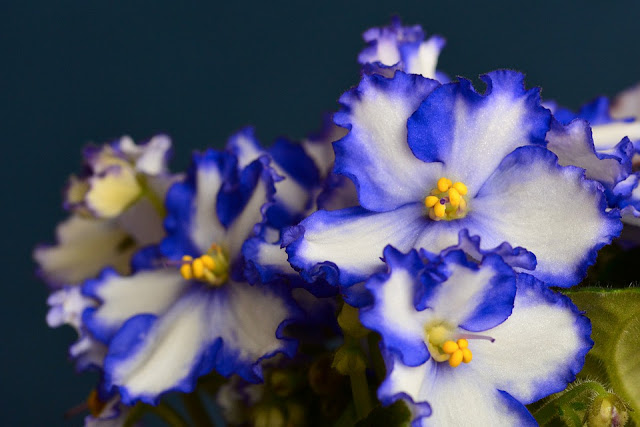African violets
have a great range of color and form. It is very easy to grow and they will
flower continuously over a long period and new plants can be grown from leaves.
African violet
known botanically as saintpaulia was first discovered in the hills of Tanzania
in East Africa. The leaves are hairy and fleshy, with long, brittle stalks.
They grow to form a rosette like mound. The flowers grow in loose clusters from
the rosette.
Size
and Growth
The African violet
can be 10 to 15 cm high and up to 38 cm or more across. Miniature varieties are
about 15 cm in diameter. Although it can bloom at any time of the year, there
are generally fewer flowers between November and March.
Color
and Varieties
These days there
are many African violet hybrids. Flower color ranges from white, through all
pink, red, blue, mauve and purple shades. The flowers may be single five petals
semi double or fully double. Much in demand are plants with two colored petals.
Frilly-edged flowers, plants with strongly variegated or crinkle edged foliages
are also very popular. Also, it is available are miniature, semi-miniature and
trailing stemmed forms.
Is
African Violets Toxic to Cats?
Many pet lovers
have question in their mind, “is African violet Safe for Cats?” The good news is
that, African violet is not toxic. Normally cats like to chew the plant leafs. May
be cats stomach is not good for digest plant material for nutritional craving.
So, African violet is not poisonous for cats and dogs.
Display
ideas
The African violet
enjoys the company of other plants so it is an ideal subject for setting in
containers with other house plants.
Making
New Plants
The easiest way to
start new plant is to take leaf cutting.
Leaf
cutting: Well, you need to propagate African violets by
taking leaf cuttings. This way you know the kind of plant and the flower color
that you will have in the end and it will be identical to the parent plant. It
will take about 8 to 10 months from taking cutting to a fully blooming adult
plant.
·
Take the leaf from the parent plant
together with its stalk.
·
Plant it so that half the stem is
covered with a rooting mixture. Keeping the cutting at temperature of 18 °C
to 21°C.
For about one month and roots will form.
·
Moreover, after 8 to 14 days at this
temperature new plantlets will appear. Once they have reached a diameter of
about 5cm then they can be split up and transferred to small pots of their own.
·
Also, water with a liquid plant food
every fortnight once the plants are well-established. Maintain high humidity by
growing plants on pebbles trays.
Plant
Doctor
1.
Brown spots scorched leaves can
appear if strong sun has been shinning directly on the leaves, or if cold water
has been spilled on them. Make sure do not expose the plant to strong sunlight
between March and October. Hence you need to give water carefully.
2.
Crown rot fungus is a major problem
with African violets. Discard the plant and clean the area where it was growing
thoroughly.
3.
Mildew can appear particularly in
winter if the surrounding air is to too moist and stagnant. Also, allow
humidity trays to dry out
4.
Sunken brown spots on undersides of
leaves. This is due to thrips or cyclamen mites. Also, discard plants under
severe attack.
Secrets
of Success to Grow African Violet
General
Care: African violets are not demanding plants but
will respond to regular and thoughtful attention, rewarding you with flowers
all year round. Pick off faded flowers and leaves right to base to maintain
only 3 to 4 layers of leaves on plants.
Potting:
This
plant grows well in open but rich potting compost. Commercial peat based
potting mixtures are best. Also, repot every spring or summer when the roots
have filled the pot. Spilt the plant with multiple crowns when repotting
Watering:
The
African violet cannot tolerate cold water on its leaves or crown. It should be
watered with tepid water from bin the saucer. Any water that remains in the
saucer after half an hour after watering should be poured off. Keep humidity
high by placing it on a tray of damp pebbles.
Feeding:
Then
you need to give it a liquid fertilizer feed every fortnight during the growth
period.
Light:
Although
the love the light, African violets cannot take very hot sunlight, especially
from March till October. The brightest possible light without hot direct sun is
ideal. During winter you cannot give them too much light.
Temperature:
You
will get the best growth and the best flowers if you plant have a summer
temperature of (15°C to 22 °C).
Minimum winter temperature should be 13°C
Lifespan:
With the right care of African violet the plant will grow for many years,
offering flowering most of the time round the year. Note the yellow pollen sacs
in this variety.
Buying
Tips
Well, if you don’t want to
invest too much time in the above process. Then these African violets are
available any time of the year in the nearest nurseries. But make sure that the
leaves are healthy and plump. That there are plenty of flower buds showing. source: Charismatic PlanetRead More - How to Care and Grow Perennial Iris Flower
Affiliates Links:
- How One Woman Discovered the Female Fat-Loss Code Missed by Modern Medicine And Lost 84lbs Using a Simple 2-Step Ritual That 100% Guarantees Shocking Daily Weight Loss
- 60 Seconds Habit ! That Reversed Type 2 Diabetes and Melted 56 lbs of Fat
- Boost Your Energy, Immune System, Sexual Function, Strength & Athletic Performance
- Diabetes Remedy # 1 Mega Offer for 2019





